Climate and climate variability and the impact of global warming on our world
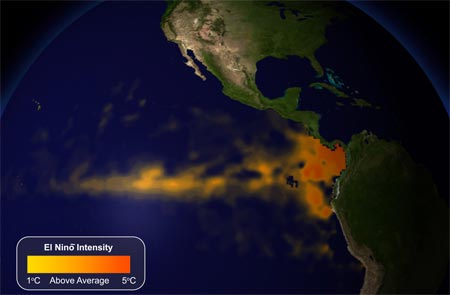 ©
NOAA
The warmer than average waters of El Niño in the Eastern equatorial Pacific (shown in orange on the map), affects weather around the world.
©
NOAA
The warmer than average waters of El Niño in the Eastern equatorial Pacific (shown in orange on the map), affects weather around the world.


Climate fluctuates all the time – over seasons and years. Winters change to spring. Some summers are warmer than others. Some years get more rain than others. This is called climate variability.
The causes of natural climate variability include: cycles and trends in the Earth’s orbit, incoming solar radiation, the atmosphere’s chemical composition, ocean circulation and its interaction with the atmosphere, and the biosphere (the sphere where life exists).
One of the main drivers of natural climate variability is El Niño. It means “little boy” in Spanish because the phenomenon appears every few years around Christmas. It causes the temperature of the normally cool surface waters of the eastern Pacific Ocean to increase and lasts for several months.
El Niño is known to have caused drought and forest fires in Australia, Indonesia and in parts of South America, but also weaker summer monsoon in South Asia, among others. El Niño is also associated with heavy rainfall and floods in parts of eastern Africa.
La Niña, which means “little girl” in Spanish, is characterized by unusually cold ocean temperatures in the eastern Equatorial Pacific Ocean. The effects of La Niña tend to be opposite those of El Niño.
Downloads:
What are El Niño, La Niña, and ENSO? [PDF]
El Niño y La Niña (In Spanish) [PDF]
Related links:
How El Niño has affected my family - UN OCHA Video
Cloud Nasara – Pacific Climate Change Science
Earth Viz: El Niño to La Niña – American Museum of Natural History [video]
El Niño and La Niña – New Zealand NIWA
El Niño and La Niña Cheat Sheet – Science Channel [video]
El Niño – Down to Earth Science and Environment Online
El Niño? – NASA Science
El Niño-Southern Oscillation (ENSO), Australian Bureau of Meteorology
NOAA El Niño: Research, Forecasts and Observations
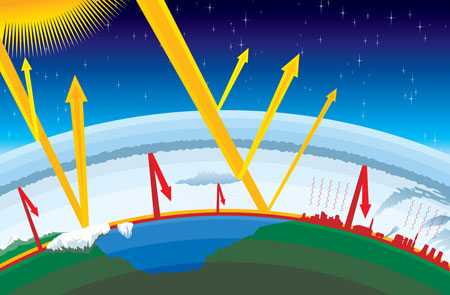 ©
daulon
The greenhouse effect
©
daulon
The greenhouse effect
Each decade is warmer.
Artic ice is melting fast.
The sea has reached its highest level in 3 000 years.
Climate changes all the time but this time it's different. People are causing much of that change – and it's happening fast.
What is global warming? Think of a blanket covering Earth.
Carbon dioxide (CO2) and other heat-trapping greenhouse gases in our atmosphere act like a blanket, trapping heat and warming the planet.
This greenhouse effect is what makes Earth hospitable. Without it the average temperature on Earth would be -18°C – too cold for most living things to exist.
The problem is that we are overloading our atmosphere with greenhouse gases from burning fossil fuels (such as oil, coal and natural gas) to heat our homes, run our cars, generate electricity, etc. This is exacerbated by destruction of tropical forests that absorb carbon dioxide.
And our planet is warming up – fast. This will have an effect on our weather and climate and sea levels.
The solution? We need to significantly reduce the amount of heat-trapping emissions. We need to burn less fossil fuels, invest in clean and renewable energy, and reduce tropical deforestation.
What can you do?
What else are you doing? Write to us to include your story on this site.
Downloads:
Climate Change Science 2013: Haiku [PDF]
Ten Signs of a Warming World poster [jpg]
What Climate Change Means for Africa and Asia [link to jpg]
We Care for Our Climate – A booklet by WMO [PDF]
Youth in Action on Climate Change: inspirations from around the world [PDF]
Related links:
Australia climate records [video]
Australian Climate Change Science Programe [video]
Cellist Coverts Climate Change Data into a Haunting Musical Composition [video]
Climate Change map – NewScientist
Climate Time Machine – NASA.gov
Connect4Climate
Green Ninja - A climate-action superhero
FAO Climate Change – Children & Youth
Learn about Climate the Pacific Way
My Climate & Me
NASA/IPCC Projections of Temperature and Precipitation in the 21st Century [video]
Outlaws in Air City [video]
Rwanda Youth Alliance for Climate Actions: Let's save the world [video]
The Earth's Next 100 Years, Visualized
The Role of Ice in the Ocean [video]
UNFCCC Youth Portal
What does climate change mean to young people?
YouthXChange Climate Change and Lifestyles Guidebook
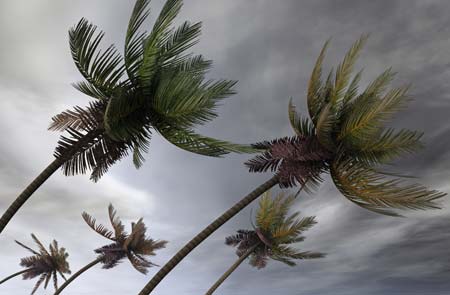 ©
Photobank gallery
Palm trees during a hurricane
©
Photobank gallery
Palm trees during a hurricane
An increase in weather extremes is now becoming more and more visible.
We cannot say for sure if any single weather event is caused by climate change. But scientists began to warn us in 1990 that one of the effects of global warming could be an increase in the number and severity of heat waves, cold snaps, droughts, storms, floods, etc.
The weather extremes of 2013 include:
Related links:
Australia climate records [video]
Arctic report card – Climate.gov
Global warming or just the weather? – Climate.gov
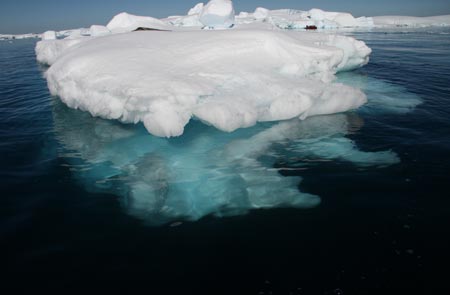 ©
Darren Begley
©
Darren Begley
Have you ever heard of climate forecasts?
Climate forecasting is complex. El Niño forecasts are among the most successful examples. These and other seasonal forecasts are used in health, disaster management, agriculture and fishery sectors.
Scientists are now working to improve climate forecasts for years and even decades ahead. This is a big challenge because the past is no longer an accurate guide to the future due to climate change.
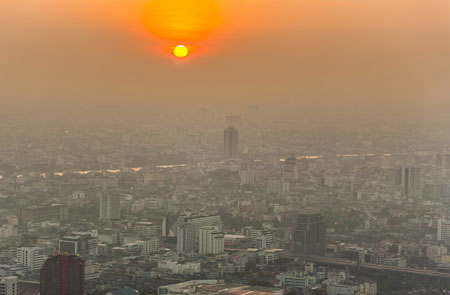 ©
Jorg Hackemann
Smog and dust in the air over Bangkok, Thailand
©
Jorg Hackemann
Smog and dust in the air over Bangkok, Thailand
Each of these are made up of aerosols – tiny particles of matter and/or drops of liquid suspended in the atmosphere and in the air we breathe.
90% of aerosols are created through natural processes. Ash spews into the atmosphere from volcanoes, dust blows into the air from deserts, sea salt is thrown up by the wind, carbon particles rise into the air during forest fires, etc.
The other 10% are from manmade sources – the burning of fossil fuels or garbage, for example – and are often a nuisance in urban and industrial areas.
Aerosols have a major impact on both our climate and our health. In terms of climate, particles in the air scatter or absorb incoming sunlight as well as trap outgoing light after it bounces off Earth's surface. They can also seed clouds or change how clouds form, therby affecting precipitation.
Because of their affect on climate, climate change projections must take aerosols into account. Aerosols are measured and monitored from global aerosol observatories, satellites and aircraft. However, the science on how exactly aerosols affect climate and climate change is still in its early stages of development.
Related links:
Aerosols: Tiny Particles, Big Impact
GAW Aerosol Research